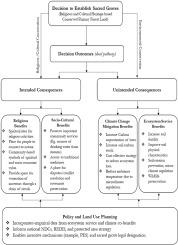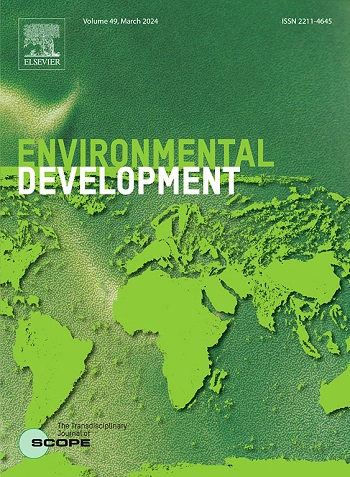Sacred groves for enhanced climate mitigation: Towards a framework for managing unintended externalities of environmental systems
IF 5.3
2区 环境科学与生态学
Q2 ENVIRONMENTAL SCIENCES
引用次数: 0
Abstract
Arguments based on the ‘land crunch’ phenomenon and its projection to further intensify in the future, thus exacerbating land use demands for food production has prompted calls and at the same time concerns on converting sacred groves (SG) for croplands or plantations. To establish the full benefits of SG beyond its primary intent of providing a religious and cultural heritage-based protected forest, we examined the potential co-benefits of SG. Consequently, the aboveground biomass (AGB), belowground biomass (BGB), amount of carbon, soil physiochemical properties in three land-use systems were empirically measured. Plantation and Cropland with scattered trees (CLST) were used as controls to the SG. The land use systems examined were from three communities in the Guinea Savanna zone of Ghana. The plot technique was used for the vegetation sampling. From the results, it was established that SG recorded the highest AGB, BGB and carbon stock with 620.6 Mg/ha, 161.4 Mg/ha and 391.0 MgC/ha respectively while the carbon stock for CLST was 341.7 MgC/ha and 124.8 MgC/ha for plantation. Similarly, SG had the highest soil carbon stock (81.5 tC/ha), compared to 66.1 tC/ha for plantation and 44.4 tC/ha for CLST. Finally, the paper then presents a decision-outcome framework, highlighting the dual pathways of intended and unintended environmental externalities for the establishment of SG. The paper demonstrates and suggests that the SG do not just deliver religious-based and socio-cultural-based (intended consequence), but they also generate co-benefits outcomes (unintended benefits) through its provision of eco-system services and helping in enhancing climate change mitigation.

促进减缓气候变化的神圣树林:建立管理环境系统意外外部性的框架
基于“土地紧缩”现象及其在未来将进一步加剧的预测的争论,从而加剧了粮食生产的土地使用需求,这引发了呼吁,同时也引发了对将圣林(SG)转化为农田或种植园的担忧。除了提供一个以宗教和文化遗产为基础的保护森林的主要目的外,为了确定SG的全部利益,我们研究了SG的潜在共同利益。在此基础上,对3种土地利用系统的地上生物量(AGB)、地下生物量(BGB)、碳量、土壤理化性质进行了实证研究。以人工林和散林田(CLST)为对照。研究的土地利用系统来自加纳几内亚稀树草原地区的三个社区。植被取样采用样地法。结果表明,SG的AGB、BGB和碳储量最高,分别为620.6 Mg/ha、161.4 Mg/ha和391.0 MgC/ha, CLST的碳储量最高,分别为341.7 Mg/ha和124.8 MgC/ha。同样,SG的土壤碳储量最高(81.5 tC/ha),人工林为66.1 tC/ha, CLST为44.4 tC/ha。最后,本文提出了一个决策结果框架,强调了建立可持续发展的预期和非预期环境外部性的双重途径。该论文论证并建议,SG不仅提供基于宗教和社会文化的(预期结果),而且还通过提供生态系统服务和帮助加强减缓气候变化产生共同效益结果(意外效益)。
本文章由计算机程序翻译,如有差异,请以英文原文为准。
求助全文
约1分钟内获得全文
求助全文
来源期刊

Environmental Development
Social Sciences-Geography, Planning and Development
CiteScore
8.40
自引率
1.90%
发文量
62
审稿时长
74 days
期刊介绍:
Environmental Development provides a future oriented, pro-active, authoritative source of information and learning for researchers, postgraduate students, policymakers, and managers, and bridges the gap between fundamental research and the application in management and policy practices. It stimulates the exchange and coupling of traditional scientific knowledge on the environment, with the experiential knowledge among decision makers and other stakeholders and also connects natural sciences and social and behavioral sciences. Environmental Development includes and promotes scientific work from the non-western world, and also strengthens the collaboration between the developed and developing world. Further it links environmental research to broader issues of economic and social-cultural developments, and is intended to shorten the delays between research and publication, while ensuring thorough peer review. Environmental Development also creates a forum for transnational communication, discussion and global action.
Environmental Development is open to a broad range of disciplines and authors. The journal welcomes, in particular, contributions from a younger generation of researchers, and papers expanding the frontiers of environmental sciences, pointing at new directions and innovative answers.
All submissions to Environmental Development are reviewed using the general criteria of quality, originality, precision, importance of topic and insights, clarity of exposition, which are in keeping with the journal''s aims and scope.
 求助内容:
求助内容: 应助结果提醒方式:
应助结果提醒方式:


